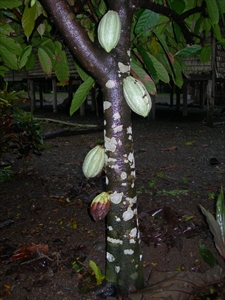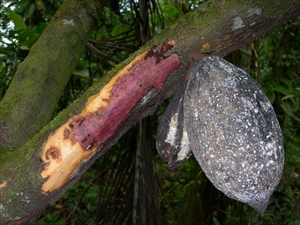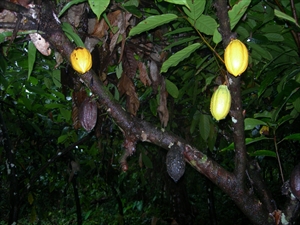Black pod
Pacific Pests, Pathogens, Weeds & Pesticides - Online edition
Pacific Pests, Pathogens, Weeds & Pesticides
Cocoa black pod (006)
Phytophthora palmivora. It is not a fungus, but an oomycete or a water mould, related to algae.
Asia, Africa, North, South and Central America, the Caribbean, Europe, Oceania. Black pod disease of cocoa is recorded from American Samoa, Federated States of Micronesia, Fiji, Palau, Papua New Guinea, Samoa, Solomon Islands, Tonga, and Vanuatu. The distribution of Phytophthora palmivora is wider in the region, and includes Australia, French Polynesia, New Caledonia, and Northern Mariana Islands.
The water mould attacks cocoa; it causes black pod and canker. Elsewhere, it causes diseases on breadfruit, coconut, papaya, and many other crops.
Phytophthora infects pods of any age, from the time they are small (when they are called 'cherelles'), to the time they are yellow and mature. Infected pods are at first brown (Photo 1), then black (Photo 2); they die but stay on the tree. Pods are destroyed in 10 days or less, depending on size
The oomycete or water mould needs water to complete its disease cycle. Spores are produced on the pods and spread in wind, heavy dew or rain to other pods nearby or to other plantations. If they land on a pod or young leaf, and it is wet, they germinate. There are two ways of germinating: (i) in warmer conditions, the spores germinate like a seed and infect the pod or leaf; or (ii) the spores produce about 20 smaller spores ('zoospores') which burst out and swim short distances over the pod or leaf surface, then they germinate and infect. In both cases, the water mould kills the cells. On pods, a brown circular spot is produced, which expands very quickly (Photo 1). On young leaves, infections often start at the leaf tip and follow the veins, which turn brown (Photo 2). Infection on the stems of water shoots causes leaves to wilt.
The water mould invades the trunk and branches causing cankers (Photo 3). This happens when the fungus in the pods or in the flowers grows back into the tree. From the outside, the branch looks healthy at first, but later cracks appear, and the infected area may be slightly sunken. When the bark is removed the red colour of the canker is seen. Trees can be killed by canker if the trunk is infected, but more often the water mould causes branch dieback.
White areas containing the spores form on the pods. Spores are also produced on the leaves, but they are less obvious. Spores on pods and leaves are splashed by rain to those all around; they also fall to the ground and remain in the soil or on leaf litter. Heavy rains splash the spores from the soil up to 1.5 m above ground, infecting pods on the trunk (Photo 1). Apart from wind and rain, spread can occur in other ways:
- The water mould in the canker grows back into the pod, via the stalk.
- Ants build 'tents' of soil containing spores over mealybug colonies on the pods (Photo 4); they may also spread spores from infected to healthy pods by walking between the two (Photo 5).
- Flying beetles that breed in the pods move spores to healthy pods.
- Rats moving through the plantation transfer the water mould by chewing first on infected and then healthy pods. Possibly, bats do the same.
- On pruning tools used to cut off pods and water shoots.
- On leaflets of the shade tree, Leucaena, which are susceptible to infection, and produce spores that fall on the pods below.
Black pod is a major disease of cocoa worldwide, causing annual losses of 20-30% of the pods and 10% of the trees from canker. In Pacific island countries, where rainfall is high, and where fungicides are not used, losses of at least 40% of the pods is common (Photo 6). The number destroyed depends on rainfall, variety and management of the trees.
The water mould is obvious on pods as brown rapidly growing spots. Cankers are less obvious; sometimes, they dry out, become sunken and there are splits between dead and healthy tissue. There may be a red ooze at the margin of the canker, but this is rare on Amelonado.
If it is not certain that Phytophthora is the cause of a black pod, take a piece of the pod, cut a hole in a healthy pod and place it in the hole. Put the pod in a plastic bag. Look for a rapidly growing brown rot, and a white area at the margin where the spores form.
CULTURAL CONTROL
Good circulation of air in the plantation is important to dry pods and leaves quickly after rain, reducing the time when infection can occur. Therefore, do the following:
Before planting:
- Use a light shade (about 600 trees per hectare if shade trees are planted).
- Plant cocoa at least 3 m apart.
- Choose areas that have good drainage. Avoid areas with heavy clay soils where surface water remains for some time after rains.
- If planting on hillsides, choose sites with morning sun to dry leaves rapidly.
During growth:
- Prune to create an open canopy: cut out branches close to the fork '(jorquette'), especially those forming a second storey; cut out branches near or touching the ground; remove water shoots ('chupons').
- Harvest pods as soon as they turn yellow and the beans are ready for processing.
- Remove diseased pods as often as possible, at least every month, preferably more often during the main crop season.
- Control rats using warfarin (or brodifacoum ) baits. Use 25-30 blocks per hectare, each with 0.05% warfarin in wheat or maize grains, and enough paraffin wax to keep the grains together. Note warfarin is banned in Europe; in the USA, so-called second generation anti-coagulants, e.g., brodifacoum, can only be used by professional pest control operators. Warfarin and brodifacoum are registered in all states and territories in Australia, but brodifacoum can only be used in and around building, not in open areas.
After harvest:
- Do not leave the shells of pods in the plantation are harvesting them to remove the beans; they will become infected and produce spores for the wind, rain and insects to carry to the developing pods.
- Take the pods from the plantation after removal of the beans, and bury or burn them.
RESISTANT VARIETIES
Amelonado is more resistant than other varieties tested in Pacific island countries, such as Na32 and Trinitario. Resistant, high yielding varieties have been bred for resistance to black pod disease in Papua New Guinea.
CHEMICAL CONTROL
Copper sprays are useful, if applied regularly (every 2 weeks) to the pods, especially during the main crop season. Trunk injections using phosphorous acid (as potassium phosphonate) are also effective. They are applied with a purpose-made syringe, once or twice a year, depending if there is low or high disease.
____________________
When using a pesticide, always wear protective clothing and follow the instructions on the product label, such as dosage, timing of application, and pre-harvest interval. Recommendations will vary with the crop and system of cultivation. Expert advice on the most appropriate pesticides to use should always be sought from local agricultural authorities.
AUTHORS Helen Tsatsia & Grahame Jackson
Information from End MJ, et al. (Eds.) 2017. Technical guidelines for the safe movement of cacao germplasm. Revised from the FAO/IPGRI Technical Guidelines No. 20 (Third Update, October 2017). Global Cacao Genetic Resources Network (CacaoNet), Bioversity International, Rome, Italy. (https://www.cacaonet.org/fileadmin/templates/CacaoNet/Uploads/publications/Safe_Movement_Guidelines_2017_En.pdf).; and Vanegtern B, et al. (2015) Black pod rot of cocoa caused by Phytophthora palmivora. College of Tropical Agriculture and Human Resources, University of Hawai'i at Manoa. (https://www.ctahr.hawaii.edu/oc/freepubs/pdf/PD-108.pdf); and from CABI (2019) Phytophthora palmivora (cocoa black pod). Crop Protection Compendium). (https://www.cabi.org/cpc/datasheet/40986).
Produced with support from the Australian Centre for International Agricultural Research under project PC/2010/090: Strengthening integrated crop management research in the Pacific Islands in support of sustainable intensification of high-value crop production, implemented by the University of Queensland and the Secretariat of the Pacific Community.









